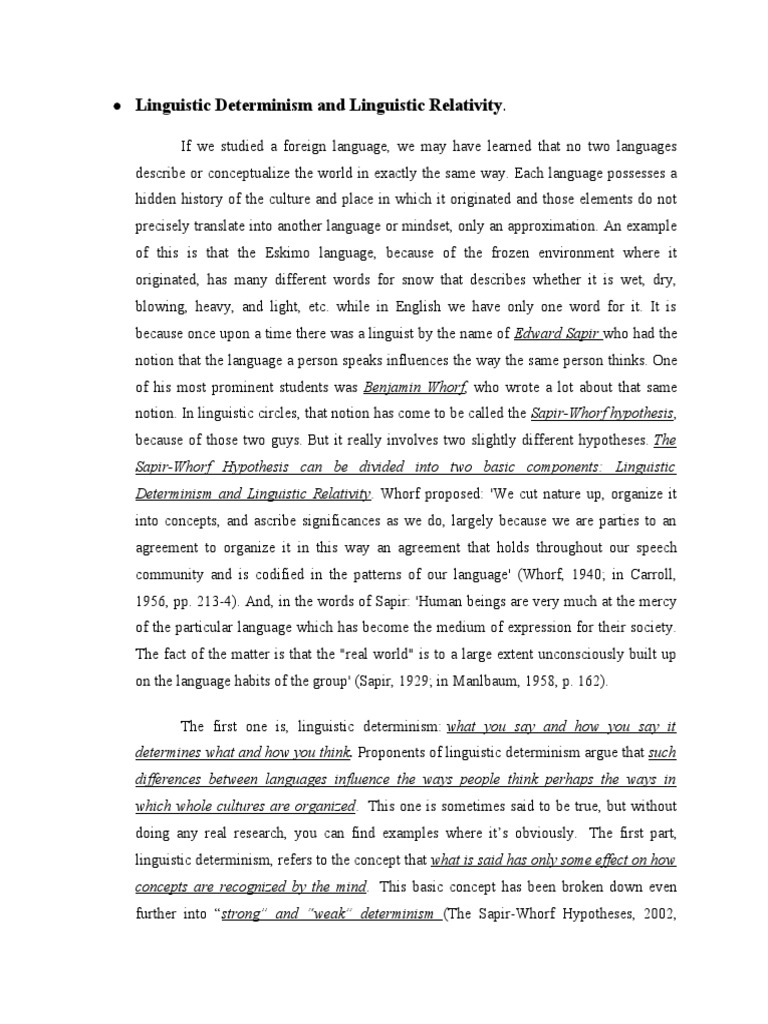Linguistic determinism is a fascinating concept that has captivated scholars and intellectuals for decades. It posits that the language one speaks significantly influences how one thinks and perceives the world. This theory raises an intriguing question: Can our choice of words define the very fabric of our reality? In exploring this concept, we delve into its roots, implications, criticisms, and the intricate relationship between language and thought.
Originating in the early 20th century, linguistic determinism is closely associated with the works of American linguists Edward Sapir and Benjamin Lee Whorf. Their analysis culminated in what is now known as the Sapir-Whorf hypothesis, which suggests that language shapes thought and that different languages create different cognitive realities. This idea was radical, positing that speakers of diverse languages might not only interpret the world differently but could be fundamentally constrained by their linguistic structures.
To consider the implications of linguistic determinism, one must examine how language manifests in cultural contexts. For instance, the way a language categorizes time influences how its speakers perceive temporal phenomena. In English, we describe time linearly, yet some Indigenous languages embrace a cyclical perspective. This divergence can alter an individual’s understanding of time, potentially leading to distinct culturally influenced behaviors and attitudes. Herein lies the playful challenge: if we were to speak a language that classifies concepts in radically different ways than our own, might we think differently about life itself?
Critics of linguistic determinism often present a counterargument known as linguistic relativity. This notion posits that language influences thought to some extent but does not wholly dictate it. For example, while the Inuit are said to have multiple words for snow, this does not imply that speakers of other languages lack an understanding of the concept. Rather, it illustrates how exposure to diverse linguistic frameworks can enrich one’s cognitive faculties, rather than restrict them. The interplay between determinism and relativity raises significant questions about the limits of human cognition and the adaptability of thought.
Exploring the nuances of linguistic determinism further reveals its implications for identity and self-perception. Language is intimately tied to culture; it embodies values, beliefs, and even social hierarchies. Consider how languages encapsulate gender, for example. In languages that utilize gendered nouns and pronouns, fluid identities may encounter challenges of expression. This linguistic architecture can influence societal perceptions and norms surrounding gender, potentially limiting the scope of individual identity. It’s a staggering realization: how much of our self-concept and social interactions are framed by the language we use daily?
Moreover, the role of language in shaping thought extends beyond mere categorization. It also encompasses the ability to articulate complex ideas and emotions. A lexicon rich in nuance allows for the expression of intricate social concepts, whereas languages lacking certain terms might constrain the ability to fully articulate those ideas. For instance, consider how emotions are linguistically represented across cultures. The word “schadenfreude,” which describes the pleasure derived from another’s misfortune, has no direct equivalent in English. This prompts us to ponder: are there feelings or cognitive experiences that are lost to us due to gaps in our linguistic repertoire?
The influence of technology on language and thought introduces another dimension to the debate. The digital era has birthed new forms of communication, such as emojis and shorthand texting, which may not align neatly with traditional grammatical structures. These evolving linguistic forms challenge the boundaries of language and thought. Do the emojis we use alter our emotional expressions? Are thought processes shaped by these concise representations? The intersection of technology and language thus raises pertinent questions about the future of linguistic determinism. How will the evolving landscape of communication reshape our cognitive frameworks, and will emerging digital dialects lead to a renaissance of thought?
Language not only reflects societal norms but also helps shape them. Consider the language used in environmental discourse surrounding climate change. Phrases like “carbon footprint” and “greenhouse gases” frame the conversation within a particular context, shaping public understanding and prompting specific actions. The terminology we adopt in environmental discussions can either galvanize collective action or instill apathy. This notion invites deeper contemplation: if language has such profound implications for behavior around climate action, what are the linguistic pathways we can explore to foster a more sustainable future?
In sum, the intricacies of linguistic determinism present a compelling tableau worthy of contemplation. Do the words we choose not merely describe our thoughts but actively mold them? As we continue to navigate a world influenced by technological advancements and cultural exchanges, the quest to understand the relationship between language and thought grows ever more significant. The challenges posed by linguistic determinism urge us to reflect upon our own experiences, identities, and the ecological futures we aspire to create. Let us embrace the intricate dance between language and thought, recognizing the profound power words hold in shaping our realities and our planet.
